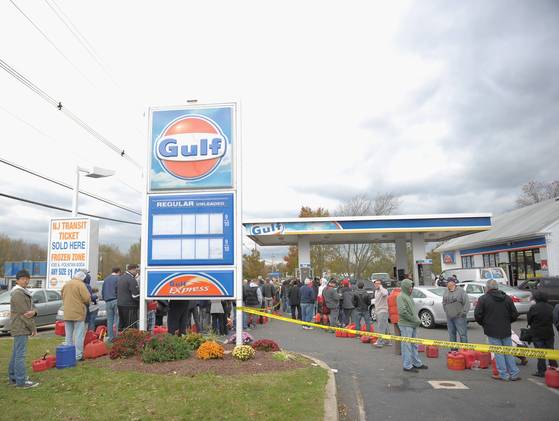Motorists Stranded At Big Oil's Pumps
 Superstorm Sandy left a trail of destruction and despair in the U.S. Northeast, but it also exposed a surprising fault line in the ability of gasoline stations to keep fuel flowing. Motorists in New York and New Jersey, desperate for gas amid constrained supply and power outages, spent hours in snaking lines waiting for a chance to hit the pumps. But those who rushed to stations bearing the names of the world's biggest and best known oil companies were the least likely to find fuel.
Superstorm Sandy left a trail of destruction and despair in the U.S. Northeast, but it also exposed a surprising fault line in the ability of gasoline stations to keep fuel flowing. Motorists in New York and New Jersey, desperate for gas amid constrained supply and power outages, spent hours in snaking lines waiting for a chance to hit the pumps. But those who rushed to stations bearing the names of the world's biggest and best known oil companies were the least likely to find fuel.
It came down to one critical factor: the outlets of the oil majors are franchised, while those of the regional chains are company-run and benefited from the full resources of their corporate parents. Three days after Sandy hit the Northeast, triggering the region's worst oil crisis since the 1970s, less than a quarter of the service stations operating under the Exxon Mobil Corp., BP, and Shell names were selling gasoline, according to analysis of industry data. The companies say the figures are higher, closer to half.
But a handful of medium-sized regional chains like Hess Corp., Wawa Inc., and Sunoco performed far better, with as many as three-quarters of their stations operating, using back-up generators to dispense fuel to millions of motorists, homeowners, and utility crews.
The vast power outages across the Northeast left thousands of stations unable to dispense fuel from their electric pumps for a week or longer, but the new analysis, based on data from intelligence firm OPIS, shows how hidden factors deepened the crisis. Oil stations branded by the three big oil companies make up a third of the market in the New York City area, the data shows, but over the past decade they have been franchised out to individual operators who enjoy little support from the multibillion-dollar majors whose name they bear. When Sandy hit, they were largely left stranded, with no easy means to hire the big generators needed to power fuel pumps. But at the other firms crisis teams swung into action, hiring dozens of units to get fuel flowing again.
 Many franchise owners would not have been able to run back-up power easily anyway -- they are not required by law to install the necessary plug-ins, a fact that came as news to New Jersey Governor Chris Christie.
Many franchise owners would not have been able to run back-up power easily anyway -- they are not required by law to install the necessary plug-ins, a fact that came as news to New Jersey Governor Chris Christie.
The breakdown in supplies has prompted calls from lawmakers to introduce rules modeled on hurricane-prone Florida, where key gas stations are required to have access to back-up power within hours of a storm. The suggestion is already meeting with fierce resistance from industry groups, who say purchasing a $30,000 generator would inflict financial hardship on station owners and convenience stores, which on average earn just $45,000 a year.
Even New Jersey-based Hess Corp, which received praise from Christie for supplying rival stations with fuel after securing eighty-five generators before the storm, has been unable to re-open its own 70,000 barrel-per-day New Jersey refinery.
The fuel shortages have hampered recovery efforts and may come back to haunt the big companies, which risk damage to their reputation from frustrated motorists even if they are not to blame.
Even with power restored and fuel moving again, there were still long lines at gas stations on snow-covered streets. New York City Mayor Michael Bloomberg ordered even-odd rationing on November 8, following the path taken by New Jersey the week prior.
New Jersey ended its rationing policy on Monday, November 12 citing that the effort had achieved the desired results.
 Superstorm Sandy left a trail of destruction and despair in the U.S. Northeast, but it also exposed a surprising fault line in the ability of gasoline stations to keep fuel flowing. Motorists in New York and New Jersey, desperate for gas amid constrained supply and power outages, spent hours in snaking lines waiting for a chance to hit the pumps. But those who rushed to stations bearing the names of the world's biggest and best known oil companies were the least likely to find fuel.
Superstorm Sandy left a trail of destruction and despair in the U.S. Northeast, but it also exposed a surprising fault line in the ability of gasoline stations to keep fuel flowing. Motorists in New York and New Jersey, desperate for gas amid constrained supply and power outages, spent hours in snaking lines waiting for a chance to hit the pumps. But those who rushed to stations bearing the names of the world's biggest and best known oil companies were the least likely to find fuel. Many franchise owners would not have been able to run back-up power easily anyway -- they are not required by law to install the necessary plug-ins, a fact that came as news to New Jersey Governor Chris Christie.
Many franchise owners would not have been able to run back-up power easily anyway -- they are not required by law to install the necessary plug-ins, a fact that came as news to New Jersey Governor Chris Christie.